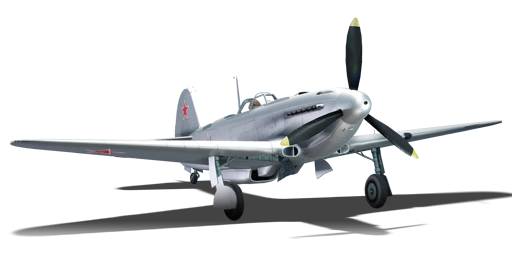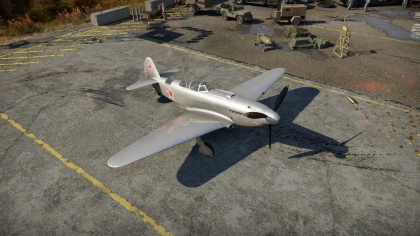Yak-9P
Contents
| This page is about the Russian fighter Yak-9P. For other uses, see Yak-9 (Family). |
Description
The Yak-9P is a rank IV Soviet fighter
with a battle rating of 5.0 (AB/RB) and 5.3 (SB). It was introduced in Update 1.31.
General info
Flight Performance
The Yak-9P's performance is similar to the Yak-3P, albeit slightly faster with a worse turn rate. The aircraft's engine performs effectively up to ~4 km before a noticeable loss of horsepower. The control surfaces start to compress at 650-700 km/h; however the aircraft will only rip at ~800 km/h, an improvement over the Yak-3.
| Characteristics | |||||||
|---|---|---|---|---|---|---|---|
| Stock | |||||||
| Max Speed (km/h at 5,000 m) |
Max altitude (meters) |
Turn time (seconds) |
Rate of climb (meters/second) |
Take-off run (meters) | |||
| AB | RB | AB | RB | AB | RB | ||
| 639 | 621 | 10,500 | 22.3 | 23.0 | 15.1 | 15.1 | 540 |
| Upgraded | |||||||
| Max Speed (km/h at 5,000 m) |
Max altitude (meters) |
Turn time (seconds) |
Rate of climb (meters/second) |
Take-off run (meters) | |||
| AB | RB | AB | RB | AB | RB | ||
| 687 | 660 | 10500 | 20.6 | 21.4 | 22.1 | 18.3 | 540 |
Details
| Features | ||||
|---|---|---|---|---|
| Combat flap | Take-off flap | Landing flap | Air brakes | Arrestor gear |
| X | X | ✓ | X | X |
| Limits | ||||
|---|---|---|---|---|
| Wing-break speed (km/h) |
Gear limit (km/h) |
Combat flap (km/h) |
Max Static G | |
| + | - | |||
| 0 | 320 | 410 | ~20 | ~15 |
| Optimal velocities | |||
|---|---|---|---|
| Ailerons (km/h) |
Rudder (km/h) |
Elevators (km/h) |
Radiator (km/h) |
| < 380 | < 420 | < 490 | > 270 |
| Compressor (RB/SB) | ||
|---|---|---|
| Setting 1 | ||
| Optimal altitude | 100% Engine power | WEP Engine power |
| 2,000 m | 1,590 hp | 1,670 hp |
| Setting 2 | ||
| Optimal altitude | 100% Engine power | WEP Engine power |
| 4,300 m | 1,510 hp | 1,530 hp |
Survivability and armour
- 8 mm Steel - Plate behind pilot's seat
- 64 mm Bulletproof glass - Pilot's head rest
- 64 mm Bulletproof glass - Front canopy window
Armaments
Offensive armament
The Yak-9P is armed with:
- A choice between three different cannons, the 20 mm B-20M, 23 mm NS-23, or the 37 mm N-37:
- 1 x 20 mm B-20M cannon, nose-mounted (115 rpg)
- 1 x 23 mm NS-23 cannon, nose-mounted (75 rpg)
- 1 x 37 mm N-37 cannon, nose-mounted (28 rpg)
- 2 x 20 mm B-20S cannon, nose-mounted (120 rpg = 240 total)
Usage in battles
When stock, the Yak-9P will be pretty similar to the Yak-3P. Three 20 mm cannons which are good taking down fighters and heavy fighters, but its still quite hard to kill big targets such like B-17. When unlocking the 23 mm cannon, the damage is higher, but it carries significantly less ammo than the 20 mm. However, when equipping the 37 mm cannon, the effectiveness of the fighter increases significantly, having weaponry close to MiG-9 or MiG-15. The 37 mm cannon has an excellent rate of fire, won't jam easily, has great accuracy and carries a good amount of ammo. A single hit can kill a fighter or heavily damage it, and big bombers like B-17s will be killed with one or two hits on a wing.
The Yak-9P is best when used in turn fights and boom and zoom attacks, but speeds of 700 km/h or higher can end on low control response (making it hard to recover) and wings breaking. It can climbs best at 20 degrees and 10-15 above 4000 m. It has great engine performance and will sightly overheat after long WEP use, but will cool down quickly when reducing to just 85-90% throttle.
One rather unique feature of the Yak-9P is the modification possibility for ones own liking. The default setup is has got a centerline B-20M. It is virtually the same as the B-20S and utilizes the same belts OR one can switch out the 20 mm for a nasty 23 mm. The suggested modification by many pilots. The NS-23 has similar ballistics to the installed 20 mm cannons but packs more punch. Fortunately the rate of fire is lower for the NS-23 and both arms will run out of ammunition at roughly the same time. For the fellow pilots who still dreams of the Yak-9T: The 37 mm "howitzer", it is a deceptive package though! The N-37 is not the NS-37 from the Yak-9T and lacks any decent anti-armour shells, losing 20 mm of penetration. Two shells were also lost from the 9T, but on the bright side it still delivers painful HE warheads to the enemy.
Manual Engine Control
| MEC elements | ||||||
|---|---|---|---|---|---|---|
| Mixer | Pitch | Radiator | Supercharger | Turbocharger | ||
| Oil | Water | Type | ||||
| Controllable | Not controllable | Not controllable | Not controllable | Separate | Not controllable | Not controllable |
Modules
| Tier | Flight performance | Survivability | Weaponry | |||
|---|---|---|---|---|---|---|
| I | Fuselage Repair | Radiator | Offensive 20 mm | New 20 mm Cannons | ||
| II | Compressor | Airframe | Offensive 23 mm | NS-23 Cannon | ||
| III | Wing Repair | Engine | New 23 mm Cannons | |||
| IV | Engine Injection | Cover | Offensive 37 mm | N-37 Cannon | New 37 mm Cannons | |
Four upgrades are of importance: Offensive 20 mm, Compressor, Engine and Engine Injection. During this grind the second weapons profile (NS-23) can be easily be obtained without wasting time or XP.
Pros and cons
Pros:
- Very fast when flying below 4000m
- Powerful armament
- Good energy retention, vertical & horizontal
- Decent rate of climb
- Decent rate of turn
- Nose mounted cannons are very accurate
Cons:
- Can't reach speeds as high as other aircraft during dives, such as Fw-190, P-51 and F4U variants
- Not very nimble at speeds lower than 300 km/h
- Control stiffening when flying above 500 kph, the roll rate is significantly decreased
- Engine horse-power significantly lower when flying above 4000m
- High repair costs
History
Describe the history of the creation and combat usage of the aircraft in more detail than in the introduction. If the historical reference turns out to be too big, take it to a separate article, taking a link to the article about the vehicle and adding a block "/ History" (example: https://wiki.warthunder.com/(Vehicle-name)/History) and add a link to it here using the main template. Be sure to reference text and sources by using <ref>, as well as adding them at the end of the article. This section may also include the vehicle's dev blog entry (if applicable) and the in-game encyclopedia description (under === Encyclopedia Info ===, also if applicable).
In-game description
"This aircraft was the last and the most advanced version of the Yak-9 fighter, which became the pinnacle of development among A. S. Yakovlev's piston-engined fighters. The Yak-9P (Product P) that appeared in 1946 was a modification of the Yak-9U fighter of composite construction. Unlike its predecessor, it had all-metal wings with elliptical tips. By this time, the manufacture of high-strength aluminum alloys was established in the Soviet Union, simplifying aircraft operation and increasing aircraft service life.
The first production aircraft were released with all-metal wings and plywood fuselage coverings, but from 1947 on these fighters were all-metal. The plywood covering over the rear fuselage was replaced with riveted duralumin.
The Yak-9P was fitted with various state-of-the-art instruments and radio communication equipment, including a radio compass and an identification friend or foe transponder, which was upgraded and improved as the aircraft's production continued. Fuel quantity in the wing-mounted tanks was significantly increased. In late 1947, the airplane's builders began installing reversible pitch propellers on some Yak-9Ps, cutting the plane's rolling distance in half and eliminating the risk of the aircraft nosing over in case it decelerated abruptly.
The fighter's armament consisted only of cannons: two synchronized 20 mm Berezin B-20 cannons and a uniform central cannon mount comprising a 37 mm Nudelman-Suranov NS-37 engine cannon with 28 rounds. The NS-37 could be replaced with a 20 mm B-20 cannon (115 rounds), a 23 mm NS-23 cannon (75 rounds), or a 45 mm N-45 cannon (26 rounds).
The Yak-9P's production continued until December 1948. By that time, 29 aircraft had been built with metal wings and a plywood-covered fuselage, and 772 planes with an all-metal construction. The Yak-9Ps were withdrawn from service with the USSR in the early 1950s.
The Yak-9P fighter was in service not only with the Soviet Union, but also with China, North Korea, Hungary, Albania, Poland, and Yugoslavia. North Korean Yaks were used during the initial stage of the Korean War, fighting against both piston-engined and turbojet enemy fighters."
Media
Excellent additions to the article would be video guides, screenshots from the game, and photos.
See also
Links to the articles on the War Thunder Wiki that you think will be useful for the reader, for example:
- reference to the series of the aircraft;
- links to approximate analogues of other nations and research trees.
External links
Paste links to sources and external resources, such as:
- topic on the official game forum;
- encyclopedia page on the aircraft;
- other literature.
| A.S. Yakovlev Design Bureau (Яковлев Опытное конструкторское бюро) | |
|---|---|
| Fighters | |
| Yak-1 | Yak-1 · Yak-1B |
| Yak-3 | Yak-3 · Yak-3 (VK-107) · Yak-3P · Yak-3T · Yak-3U |
| Yak-7 | Yak-7B |
| Yak-9 | Yak-9 · Yak-9B · Yak-9K · Golovachev's Yak-9M · Yak-9P · Yak-9T · Yak-9U · Yak-9UT |
| Twin-engine fighters | I-29 |
| Jet fighters | |
| Yak-15 | Yak-15P · Yak-15 |
| Yak-17 | Yak-17 |
| Yak-23 | Yak-23 |
| Yak-30 | Yak-30D |
| Yak-141 | Yak-141 |
| Strike aircraft | |
| Yak-2 | Yak-2 KABB |
| Yak-38 | Yak-38 · Yak-38M |
| Bombers | Yak-4 |
| Jet bombers | Yak-28B |
| Foreign use | ▄Yak-3 · Challe's ▄Yak-9T · ◔Yak-9P |
| Captured | ▀Yak-1B |
| USSR fighters | |
|---|---|
| I-15 | I-15 WR · I-15 M-22 · I-15 M-25 · I-15bis · Krasnolutsky's I-15bis |
| I-153 M-62 · Zhukovsky's I-153-M62 · I-153P | |
| I-16 | I-16 type 5 · I-16 type 10 · I-16 type 18 · I-16 type 24 · I-16 type 27 · I-16 type 28 · I-180S |
| I-29 | I-29 |
| I-185 | I-185 (M-71) · I-185 (M-82) |
| I-225 | I-225 |
| ITP | ITP (M-1) |
| MiG-3 | MiG-3-15 · MiG-3-15 (BK) · MiG-3-34 |
| LaGG | I-301 · LaGG-3-4 · LaGG-3-8 · LaGG-3-11 · LaGG-3-23 · LaGG-3-34 · LaGG-3-35 · LaGG-3-66 |
| La | La-5 · La-5F · La-5FN · La-7 · Dolgushin's La-7 · La-7B-20 · La-9 · La-11 |
| Yak-1/7 | Yak-1 · Yak-1B · Yak-7B |
| Yak-3 | Yak-3 · Yak-3P · Yak-3T · Yak-3U · Yak-3 (VK-107) |
| Yak-9 | Yak-9 · Yak-9B · Golovachev's Yak-9M · Yak-9T · Yak-9K · Yak-9U · Yak-9UT · Yak-9P |
| Other countries | ▂P-40E-1 · ▂P-47D-27 · ▂Hurricane Mk IIB · ▂Fw 190 D-9 · ▂Spitfire Mk IXc |
| P-39 | ▂P-39K-1 · ▂Pokryshkin's P-39N-0 · ▂P-39Q-15 |
| P-63 | ▂P-63A-5 · ▂P-63A-10 · ▂P-63C-5 |





